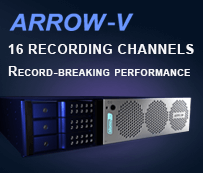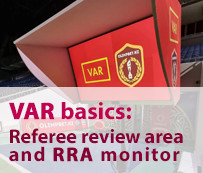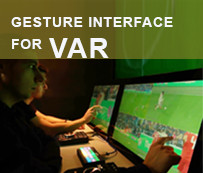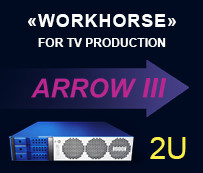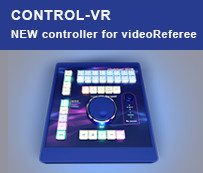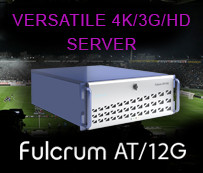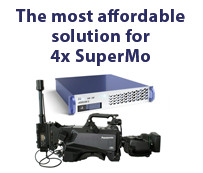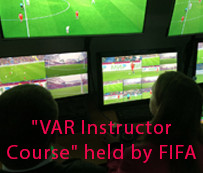Glossary
The SLOMO.TV Glossary is a list of terms from the world of video production.
- Academy SLOMO.TV
- AES(Standards)
- AES
- CEC (Consumer Electronics Control)
- Control ZR
- Control-MC
- Control-VR
- D-sub
- DANTE
- DMR™ (Direct Movie Record)
- DVI (Digital Visual Interface)
- Embedded audio
- Gesture interface
- GPIO (General Purpose Input/Output)
- HDMI™ (High-Definition Multimedia Interface)
- Hi-Motion
- In-Goal
- Linear editing
- Linear Timecode
- Match controller
- mini-II-GoalNetCam
- mini-II-vR-cam
- Multiviewer
- Non–linear editing
- NTSC (National Television System Committee)
- OB van, television production truck
- PAL (Phase Alternating Line)
- PGM (Program)
- PoE
- ProRes
- PVW(Preview)
- SDI (Serial Digital Interface)
- Slo-mo or Slow-mo
- Slow motion (cameras)
- SMPTE
- Timelapse
- UHD (Ultra High Definition)
- VAR
- videoReferee®
- vR-Keypad
- XLR
- Аcademy SLOMO.TV
- The Academy is a specialized hardware and software system from SLOMO.TV created to train video production
specialists. The system simulates live signals to allow the trainees to immerse themselves into working
conditions as close to real as possible.
The Academy has a wide range of applications, including training of directors, VARs, replay operators and other TV specialists. The Academy solution can be implemented as a stand-alone device or as an option for any of the SLOMO.TV servers.
Learn more about the Academy courses - AES (Standards)
-
AES standards are developed by the Audio Engineering Society (AES) and cover various aspects of audio technology, equipment, and practices.
Some notable AES standards include:
- AES3 (AES/EBU): Specifies the professional digital audio format with a signal that can carry two channels of digital audio over several transmission media.
- AES10 (MADI – Multichannel Audio Digital Interface): Specifies a protocol for transporting multiple channels of digital audio over a single cable.
- AES67: Specifies high-performance audio-over-IP (AoIP) and audio over Ethernet (AoE) interoperability.
- AES70 (Open Control Architecture): Specifies a communications protocol architecture for media networks designed to provide a common framework for device control and monitoring.
- AES-X075 (X-format): Describes a file format for the interchange of audio programs and associated data.
- AES
-
The Audio Engineering Society (AES) is a professional association for audio engineers and those involved in
the audio industry. It was established in 1948 and serves as a platform for professionals to exchange ideas,
knowledge, and experiences related to audio technology and engineering.
AES organizes conferences, conventions, and publishes a variety of resources, including journals and standards, to advance the field of audio engineering. The society covers a wide range of topics, including sound recording, reproduction, and transmission, as well as acoustics and multimedia.
- CEC (Consumer Electronics Control)
-
Consumer Electronics Control (CEC) is a technology that allows multiple consumer electronics devices to
communicate and control each other over an HDMI connection. It simplifies the user experience by enabling a
single remote control to operate various connected devices.
Key features of CEC include:
- Single Remote Control: Users can control multiple devices, such as TVs, Blu-ray players, audio systems, and more, using a single remote control.
- Power Control: CEC allows devices to turn on and off together. For example, turning on a Blu-ray player may also power on the TV and switch it to the correct input.
- Volume Control: Users can adjust the volume of compatible devices using a single remote control.
- Control ZR
-
Control ZR is a specialized remote control equipped with 51 buttons with RGB backlighting, light and color
indications and operator prompts.
Control ZR provides direct access to 24 cameras in replay mode. The controller is equipped with a highly reliable and accurate T-bar and Jog/Shuttle. The Shuttle wheel has 64 steps left and right to control search and slow motion speeds. Control ZR connects via RS-232/422, USB and Ethernet. The remote control is powered via PoE or USB.
Using the control panel significantly speeds up and simplifies the operator's work.
- Control-MC
-
Control-MC is a scoreboard controller by SLOMO.TV with the following features:
- 22 large tactile RGB broadcast push-buttons with functional contextual backlighting;
- 7" color TFT touchscreen interface for displaying game information and working with non-operational menus;
- Multiple interfaces for connecting to the infrastructure;
- Built-in rechargeable Li-ion battery for up to 6.5 hours of continuous operation.
Control-MC supports a variety of sports, including ice hockey, basketball, water polo and handball.
Control-MC offers the innovative wireless Smart Whistle function: the time on the scoreboard controller starts and stops by the referee's whistle. For TV broadcasters who produce on-air graphics from a broadcasting center there is a SCDO option.
Learn more about the scoreboard controller - Control-VR
-
Control-VR is a control panel designed specifically for videoReferee®
VAR systems, providing direct access to 32 cameras and Virtual Offside Line support.
Control-VR has several modes of operation: direct access to cameras; work with presets; quad or 2-camera views.
It can be powered by PoE and connected via USB, Ethernet, RS232/422 (using the standard SLOMO.TV technology).
Other features:
- User-friendly, intuitive and fast interface.
- 35 large reliable RGB-backlit buttons with color prompts.
- Keyword assignment, tag search and timecode navigation, creating presets and split-screens for video referees.
- Reliable and responsive Jog/Shuttle.
- Shuttle wheel controls search and slow motion playback speeds.
- Active control transfer when using multiple replay operator workplaces.
- Versatile connectivity – Ethernet, USB, RS-422/232.
- D-sub
-
The term “D-sub” (D-subminiature) refers to a type of electrical connector commonly used in computing and
other electronic devices.
The name “D-sub” comes from the D-shaped metal shield that surrounds the connector. These connectors have multiple pins arranged in two or more rows. D-sub connectors are known for their durability and reliability, making them suitable for a variety of applications. The most common types of D-sub connectors include:
- DB-9 (9-pin D-sub): Often used for serial communication, such as RS-232 connections.
- DB-15 (15-pin D-sub): Commonly found in VGA (Video Graphics Array) connections for computer monitors.
- HD15 (High-Density 15-pin D-sub): Similar to DB-15 but with a higher pin density. Used for VGA or GPIO connections.
- DB-25 (25-pin D-sub): Used for various applications, including parallel printer ports and some serial connections.
- DANTE
-
Digital Audio Network Through Ethernet (DANTE) is an audio-over-IP (AoIP) networking technology developed by
Audinate. It facilitates the transport of high-quality, low-latency digital audio signals over standard
Ethernet networks. DANTE has gained popularity in the professional audio industry for its ability to simplify
audio networking and enhance flexibility in audio system installations.
Key Features of DANTE:
- Ethernet-Based: DANTE operates over standard Ethernet networks, making it compatible with existing IT infrastructures. This widespread compatibility allows for easy integration into various environments.
- Low Latency: DANTE provides low-latency audio transmission, making it suitable for applications where real-time audio synchronization is crucial, such as live performances and broadcasting.
- Scalability: DANTE supports the creation of complex and scalable audio networks. Users can connect multiple devices, including mixers, amplifiers, microphones, and speakers, to the same network and route audio as needed.
- Device Compatibility: Many audio equipment manufacturers have adopted DANTE, resulting in a wide range of DANTE-enabled devices. This ensures compatibility and interoperability within the audio ecosystem.
- Software-Based Control: DANTE offers software tools for configuring and managing audio devices on the network. This simplifies the setup and monitoring of audio systems.
- Redundancy: DANTE supports network redundancy, providing increased reliability. In mission-critical audio applications, redundant network paths can be established to ensure continuity.
- Wide Industry Adoption: DANTE has gained widespread adoption in the professional audio industry. It is used in various applications, including live sound reinforcement, recording studios, broadcast facilities, and more.
- DMR™ (Direct Movie Record)
- The DMR™ (Direct Movie Record) technology developed by SLOMO.TV is supported by most SLOMO.TV systems and allows simultaneous real-time recording of video not only to a RAID array, but also recording of HD video and SD proxies in the “native” formats of non-linear video systems.
- DVI (Digital Visual Interface)
-
Digital Visual Interface (DVI) is a video display interface used to connect a computer or other devices to a display, such as a monitor or projector. It provides a high-quality, digital connection for transmitting video signals. DVI has become less common in recent years as newer interfaces such as HDMI (High-Definition Multimedia Interface) and DisplayPort have gained popularity. DVI does not carry audio, so a separate audio connection may be required if audio is part of the multimedia content.
There are several types of DVI connectors:
- DVI-I (Integrated): This connector supports both digital and analog signals, making it versatile for different display devices.
- DVI-D (Digital): This connector supports only digital signals, providing a purely digital connection between the source and the display.
- DVI-A (Analog): This connector only supports analog signals and is less common in modern devices.
- Embedded audio
-
Embedded audio refers to an audio recording that is embedded in some type of content, such as web pages,
presentations, videos, etc. This usually means that an audio file (such as a music track or sound effects) has
been integrated into another multimedia format to be played in the context of that format. Audio embedding
ensures that the audio is synchronized with other content elements to create a single multimedia playback.
In video production, sound embedding refers to the embedding of audio signals into an SDI video signal. Depending on the type of audio signal (AES/EBU, MADI or DANTE), different specialized devices are used to embed the sound.
For more information about embedding sound, see the article “Audio in SLOMO.TV servers – Solutions for analog signals, AES/EBU, MADI and DANTE”.
- Gesture interface
-
Gesture interface allows the user to interact with a device using certain movements of the hands, fingers, face, or other parts of the body. This type of interface is based on detecting and interpreting movements of the human body or parts of the body.
Gesture interfaces are widely used in modern devices such as smartphones, tablets, game consoles and smart TVs to provide a more natural and convenient way to interact with technology.
Examples of gesture interfaces include:
- Gesture recognition on touchscreens, such as zooming or rotating with two fingers;
- Using cameras or motion sensors to track the user's body movements, for example in gesture control for games or virtual reality;
- Recognizing certain hand gestures to perform commands, such as waving your hand to control the media player.
- GPIO (General Purpose Input/Output)
-
GPIO, which stands for General Purpose Input/Output, is a type of interface commonly found on microcontrollers, single-board computers, and other hardware platforms. It allows these devices to interact with external hardware components such as sensors, LEDs, buttons, and other electronic peripherals.
Here are some key points about GPIO:
- Digital Pins: GPIO pins can be configured as either inputs or outputs for digital signals (high/low, on/off). When configured as inputs, they can read the state of external devices (e.g., a button press), and when configured as outputs, they can control the state of external devices (e.g., turning on an LED).
- Flexibility: The “general-purpose” aspect of GPIO means that these pins can be used for a wide range of functions, depending on how they are configured by the software running on the device.
- Interfacing with Hardware: GPIO pins are used to interface with a variety of hardware components, including sensors, motors, displays, and communication modules. For example, you might use GPIO pins to read data from a temperature sensor or control the direction of a motor.
- Programming: To work with GPIO pins, developers typically write code in programming languages like Python, C/C++, or others, depending on the platform. The code configures the pins, reads input states, and sets output states as needed.
- Voltage Levels: GPIO pins can operate at different voltage levels, depending on the device or platform. Common voltage levels include 3.3V and 5V.
- Raspberry Pi and Arduino: GPIO pins are prominently used in platforms like the Raspberry Pi and Arduino, where they play a central role in creating projects and prototypes.
- HDMI™ (High-Definition Multimedia Interface)
-
HDMI™, or High-Definition Multimedia Interface, is a widely used interface for transmitting uncompressed audio
and video data between devices. It has become the standard for connecting various consumer electronics,
particularly in the home entertainment sector.
Here are key features and aspects of HDMI™:
- High Definition: HDMI supports high-definition video and audio signals, making it suitable for connecting devices such as HDTVs, Blu-ray players, gaming consoles, and audio/video receivers. It is capable of carrying both standard and high-definition resolutions, including 720p, 1080i, and 1080p.
- Audio and Video in a Single Cable: Simplifies cable management and reduces clutter in home entertainment setups.
- Versions and Specifications: Features such as higher resolutions, increased color depth, and support for advanced audio formats have been introduced in newer versions.
- Connectors: HDMI cables use a distinctive, compact connector that carries both digital video and audio signals. HDMI connectors come in various sizes, with the standard Type A being the most common. Mini HDMI and Micro HDMI connectors are smaller versions used in certain devices like cameras and smartphones.
- Content Protection: HDMI includes High-bandwidth Digital Content Protection (HDCP) to prevent unauthorized copying of protected content.
- Backward Compatibility: HDMI™ is designed to be backwards compatible, allowing newer devices to work with older HDMI-equipped devices.
- Applications: HDMI™ is used in a wide range of consumer electronics (TVs, monitors, projectors, audio/video receivers, DVD and Blu-ray players, gaming consoles, and digital cameras) and various professional audio/video applications.
- Hi-Motion
-
Hi-Motion is a technology designed to capture fast-paced events in exceptional detail, allowing detailed
analysis of rapid movements such as those that occur in sports.
Key features of Hi-Motion technology include:
- High Frame Rate Capture: High frame rate enables smooth slow-motion playback with no loss of image quality.
- Slow-Motion Analysis: The primary purpose of Hi-Motion technology is to enable slow-motion analysis of fast and dynamic events, such as sports activities.
- Enhanced Detail: High frame rates capture results in enhanced detail and clarity during slow-motion playback.
- Sports Broadcasting: Hi-Motion technology enhances the viewer's experience by providing detailed and slowed-down replays in sports like football (soccer), basketball, tennis, and other fast-paced games.
- Specialized Cameras: Cameras equipped with Hi-Motion technology incorporate advanced image sensors and processing capabilities to handle the demands of high frame rate capture.
- Analytical Tools: Analytical tools and software enable broadcasters and analysts to break down and dissect key moments in a game or event.
- In-Goal
-
In-Goal cameras are video cameras installed inside the goal and designed to monitor events in the goal area.
In the context of hockey and football matches, in-goal cameras provide additional angles for analyzing the
events in the goal area and making decisions by referees or video refereeing systems.
Recent developments in technology have enabled goal cameras to feature wireless data and control transmission, long battery life, and increased resistance to external shocks and temperature fluctuations. The SLOMO.TV mini-II-GoalNetCam in-goal cameras have all these functions.
In-goal camera operation at a hockey match:
- Linear editing
-
Linear editing is a traditional method of making a film in which scenes are edited in a strictly linear order,
as they were shot. This approach was used before the introduction of digital technologies and non-linear
editing systems.
Here are some key features of linear editing:
- Sequence of scenes: Scenes are edited in the order in which they were shot, so changing the order of the scenes requires reshooting the entire film.
- Limited flexibility: With linear editing, the ability to change the structure and chronology of a movie is constrained, limiting creative freedom.
- Time-consuming: Changing or correcting any part of the movie requires the editor to redo and reassemble all the previous scenes, which takes a lot of time.
- Limited technical capabilities: Linear editing often limits the use of complex technical effects, animation and other innovative techniques.
- Fixed structure: The fixed structure of the movie makes it difficult to correct mistakes or change the creative vision after the first cut.
- Linear Timecode
-
Linear Timecode (LTC) is a standardized method for encoding time information in audio and video signals,
providing frame-accurate synchronization in professional production environments. Its widespread use and
compatibility make it an essential tool in the field of audio and video production.
Key features of Linear Timecode include:
- Time Reference: LTC provides a continuous and linear representation of time, allowing precise synchronization between different audio and video devices. It sequentially encodes hours, minutes, seconds, and frames.
- Frame Accuracy: LTC is capable of addressing individual frames, providing a high level of timekeeping accuracy.
- SMPTE Standards: LTC conforms to the standards of the Society of Motion Picture and Television Engineers (SMPTE). The most common LTC format is based on SMPTE timecode standards, such as SMPTE ST 12-1, which defines the structure of timecode information.
- Recording on Audio Tracks: LTC is often recorded on one of the audio tracks of a video so that timecode information can be embedded in the recorded media.
- Syncing Multiple Devices: LTC ensures that the various elements of a production are accurately timed by synchronizing the various devices involved.
- Compatibility: Linear Timecode is widely supported in professional audio and video equipment, enabling interoperability between different devices from different manufacturers.
- Drop-Frame and Non-Drop-Frame: Drop-frame timecode adjusts for the discrepancy between the nominal frame rate and the actual time, helping to keep time accurate over long periods of time.
- Editing and Post-Production: LTC is critical for accurately aligning audio and video tracks. Editors use LTC information to synchronize multiple sources and ensure precise timing in the final production.
- Match controller
-
A match controller (scoreboard controller) is a device that provides game time management, score tracking,
public information display, and other functions for various aspects of sports competitions.
SLOMO.TV has developed its own scoreboard controller Control-MC, suitable for a variety of different sports.
- mini-II-GoalNetCam
- A wireless gate (for installation in a gate) Full HD camera with an ultra wide-angle lens covers the entire area of the gate, is protected from mechanical influences, condensation and operates at low temperatures. Kevlar-reinforced plastic and a specially shaped protective camera body, designed using advanced CAD tools, ensure that the camera will survive repeated contact with the puck and will not be damaged if a hockey player collides with the camera during a goalmouth scramble.
- mini-II-vR-cam
-
mini-II-vR-Cam is a specialized Full HD video camera for video judging systems in sports competitions. The
camera is used to record events in real time and play slow-motion frames for detailed analysis and
decision-making in sports.
Distinctive features of mini-II-vR-Cam cameras:
- Support for 3G and HD modes;
- Cloud synchronization – CloudyGenLock®;
- Controlled zoom lens;
- Reliable and impact resistant design;
- Analog audio input with sound volume display;
- Power supply and control via Ethernet – PoE;
- Compliance with Video Goal technical regulations;
- Absolute synchronicity and “in-phase” with each other (when using cloud sync mode).
- Multiviewer
- Multiviewer is a system that receives multiple video signals and then processes, scales, arranges and displays them on one or more video monitors, allowing the user to conveniently access multiple channels on a single display.
- Non–linear editing
-
Non-linear editing is a versatile modern video editing method that allows video clips to be moved and edited
out of sequence. NLE changed the movie industry with the development of digital video editing technologies.
Here are some basic advantages:
- Flexibility and creative freedom: Directors and editors are free to change the order of scenes, try different options, experiment with the chronology of events.
- Easy error correction: When errors or unsuccessful scenes are detected during non-linear editing, they can be easily corrected without affecting the rest of the film's structure.
- Work efficiency: Modern non-linear editing software offers a wide range of tools and effects to make the workflow more efficient and convenient.
- Adding effects and animation: Non-linear editing makes it easy to add special effects, animation, color correction and other technical enhancements without having to re-edit the entire video.
- Collaboration and sharing: The ability to work on a project remotely and share files digitally simplifies teamwork at various stages of film creation.
- Storage and management: The digital format enables efficient storage and management of large volumes of video, simplifying access to different versions and elements of the project and reducing production time.
- NTSC (National Television System Committee)
-
NTSC is an analog television broadcasting standard used in North America, parts of South America, and some
other regions. It was developed by the National Television System Committee, an American technical
organization, and became the official analog television broadcasting standard in the United States in the
mid-20th century, but has been replaced by digital standards in many regions due to advances in technology and
improved signal quality.
NTSC's key features:
- Color Encoding: NTSC combines luminance (brightness) and chrominance (color) information to enable the transmission of color television.
- Frame Rate: NTSC has a frame rate of approximately 29.97 frames per second (fps), with each frame consisting of two interlaced fields.
- Interlaced Format: Interlacing method was chosen to reduce flicker on early CRT (cathode-ray tube) displays.
- Resolution: NTSC has a resolution of 525 horizontal lines per frame, with an aspect ratio of 4:3.
- Audio Transmission: The audio is frequency modulated (FM) and is transmitted on a separate carrier frequency.
- Color Subcarrier Frequency: The color subcarrier frequency is 3.579545 MHz.
- Obsolete Standard: While NTSC was widely used for analog television broadcasting for several decades, the transition to digital television standards has made it obsolete in many regions.
- Legacy Equipment: Some older televisions and video equipment may still support NTSC signals, but modern displays and broadcast systems have largely moved to digital standards.
- OB van, television production truck
-
A television production truck, also known as a mobile production unit or OB van (Outside Broadcast Van), is a
mobile production vehicle equipped with broadcast and production facilities for location shooting or broadcast
production. Without the need for fixed studio setups, OB vans are often used to cover live events such as
sports, news, concerts, and other remote broadcasts.
Here are the key features typically found in TV production trucks:
- Control Room: The truck houses a control room where technicians and producers operate the equipment using video and audio control panels, monitors, and communication systems.
- Cameras and Lenses: Production trucks are equipped with high-quality cameras and lenses to capture live footage, often mounted on the outside of the truck to provide multiple angles.
- Video Switcher: A video switcher allows operators to switch between different camera feeds, graphics, and pre-recorded content during a live broadcast.
- Audio Mixer: An audio mixer is used to control and balance audio from various sources, including microphones, ambient sounds, and prerecorded audio.
- Graphics & Character Generator: Production trucks are equipped to generate on-screen graphics, overlays, and text to provide viewers with relevant details about the broadcast.
- Satellite Uplink/Downlink: To broadcast live, production trucks are often equipped with satellite communications systems.
- Lighting Equipment: Adequate lighting is essential for capturing clear and well-lit images.
- Power Systems: Integrated power systems (generators and emergency power supplies) support all on-board electronic equipment.
- Editing Facilities: Some advanced production trucks may have basic editing capabilities for making on-the-fly edits or preparing content for later use.
- Cabling and Connectivity: Extensive cabling is required to connect all the equipment within the production truck. This includes video, audio, and power cables.
- PAL (Phase Alternating Line)
-
PAL is a color television broadcasting standard that offers improved color accuracy and stability compared to
NTSC. It was widely used in various regions but has been largely replaced by digital television standards in
recent years.
PAL's key features:
- Color Encoding: PAL uses a phase-alternating technique to encode color information and provide high-quality color reproduction.
- Frame Rate: PAL operates at a frame rate of 25 frames per second (fps) consisting of two interlaced fields.
- Interlaced Format: Interlacing helps reduce flicker on CRT displays.
- Resolution: PAL has a resolution of 625 horizontal lines per frame with a 4:3 aspect ratio.
- Color Subcarrier Frequency: The color subcarrier frequency is 4.43361875 MHz.
- Audio Transmission: The audio is frequency modulated (FM) and is transmitted on a separate carrier frequency.
- Greater Color Accuracy: PAL's phase-alternating technology helps reduce color errors and artifacts in the transmitted image.
- Widespread Adoption: PAL has been widely adopted in Europe and several other regions, making it one of the most widely used analog television standards in the world.
- Transition to Digital: With the transition to digital television standards in many parts of the world, PAL has become largely obsolete.
- PGM (Program)
- PGM (Program) is a signal or output that represents the main, broadcast-ready video signal that viewers will ultimately see.
- PoE
-
Power over Ethernet (PoE): Brief Overview
Power over Ethernet (PoE) is a technology that enables the simultaneous transmission of electrical power and data over Ethernet network cables, offering a practical and efficient solution for various applications.
Here are the key points about PoE:
- Single Cable for Power and Data: PoE allows both data and power to be delivered over a single Ethernet cable, which is especially useful for networked devices.
- IEEE Standards: PoE is based on IEEE (Institute of Electrical and Electronics Engineers) standards - the most common are IEEE 802.3af (PoE) and IEEE 802.3at (PoE+).
- Power Sourcing Equipment (PSE): Power Sourcing Equipment (PSE) supplies power to Powered Devices (PD) over the Ethernet connection.
- Powered Devices (PD): Powered Devices (PD) are devices that receive power over Ethernet cables.
- Voltage and Power Levels: Different PoE standards support different voltage levels and power capacities.
- Installation Flexibility: PoE allows for flexible device placement without the constraints of power availability.
- Network Efficiency: PoE consolidates power and data infrastructure, reduces cable clutter, simplifies cable management, and lowers installation costs.
- PoE Variants: PoE+ (802.3at) and PoE++ (802.3bt) support higher power requirements, making them suitable for high-performance and industrial devices.
- ProRes
-
ProRes is a professional video codec developed by Apple, known for its high-quality compression, efficient
editing performance, and widespread adoption in the film and video production industry. It is designed to
provide high-quality, visually lossless compression for professional video editing and post-production
workflows.
Here are key features and aspects of ProRes:
- Professional Video Codec: ProRes offers a balance between high image quality and manageable file sizes.
- Intra-frame Compression: Each video frame is compressed independently for efficient editing.
- Variants of ProRes:
- ProRes 422: Offers high-quality HD video at a moderate data rate.
- ProRes 422 HQ: Provides higher data rates for better image quality.
- ProRes 422 LT: Lower data rates suitable for smaller file sizes.
- ProRes 4444: Supports high-quality with an alpha channel (transparency).
- ProRes XQ: The highest quality with the highest data rates.
- Editing Efficiency: ProRes enables efficient performance in nonlinear editing (NLE) systems – smooth playback and real-time editing even with high-resolution, high-bitrate footage.
- Color Accuracy: ProRes supports 10-bit and 12-bit color depths.
- Wide Industry Adoption: ProRes is widely used in the film, television, and video production industries and is supported by a variety of video editing software, hardware, and professional video equipment.
- Cross-Platform Compatibility: Because ProRes can be used on both MacOS and Windows-based systems, it is popular in mixed-platform post-production environments.
- Bitrates and File Sizes: Users can select different bit rates depending on the desired balance between image quality and file size.
- PVW(Preview)
- PVW (Preview) is a signal or output that represents a preview of the video signal that is being prepared for broadcast. PVW is typically used to pre-screen or review content before it is actually broadcast or recorded. It allows camera operators or video editors to view footage before final delivery and decide what changes may be necessary.
- SDI (Serial Digital Interface)
-
SDI (Serial Digital Interface) is a standardized digital interface used for transmitting uncompressed and
unencrypted video data. SDI has become a standard in the broadcast industry due to its reliability,
high-quality transmission, and versatility in handling various video formats.
Key features of SDI include:
- Uncompressed Video: SDI transmits video signals without compression, maintaining high image quality.
- Data Rates: SDI can support different data rates, including standard definition (SD-SDI), high definition (HD-SDI), and ultra-high definition (UHD-SDI).
- Coaxial Cable: SDI is typically transmitted over coaxial cable because of its durability and ability to carry high-frequency signals over long distances.
- BNC Connectors: BNC (Bayonet Neill-Concelman) connectors provide a secure and reliable connection between devices using SDI.
- Single Cable for Multiple Signals: SDI can carry video, audio, and metadata signals simultaneously over a single cable, simplifying the overall setup.
- Broadcast and Professional Applications: SDI is widely used in broadcasting, live production, post-production, and other professional video environments.
- Long Cable Runs: SDI can support long cable runs without significant signal degradation, making it suitable for large production setups.
- Slo-mo or Slow-mo
-
Slow motion is a technique in cinematography and video production in which frames are played back at a slower
speed than usual in order to emphasize details, create a smooth effect, or provide a closer look at the scene.
Slow motion is often used in sports broadcasts, movies, and video clips to create an aesthetic effect or make the viewer analyze an event.
- Slow motion (cameras)
-
Slow-motion cameras are cameras with a high frame rate that allows you to convey an accurate and detailed
slow-motion image. Slow motion cameras are widely used in the film industry, television, live and sports
broadcasts.
Example: Replays Mix Fight Combat Jeff Monson
- SMPTE
-
SMPTE time code, developed by the Society of Motion Picture and Television Engineers, is a standardized system
for labeling individual frames in audiovisual content.
It serves as a precise time reference, allowing for synchronization and accurate editing during post-production. The time code includes hours, minutes, seconds, and frames, providing a consistent and universal means of tracking time within audiovisual materials.
- Timelapse
-
Timelapse is a shooting technique in which frames are captured at a certain time interval and then played back
with acceleration. This creates the effect of accelerated passage of time. The process can be used to observe
changes in nature, construction, cloud movement and other processes that are not noticeable in everyday life
due to their slow progress.
Timelapse is also actively used in the creation of cinematic effects.
- UHD (Ultra High Definition)
- UHD (Ultra High Definition) is a term used to refer to an image resolution that is significantly higher than standard high resolution (HD). UHD usually means a resolution of 3840 x 2160 pixels, which is four times the resolution of 1080p (Full HD). This provides a more detailed and clear visual reproduction, especially on large screens, where the increased pixel density increases the clarity of the image.
- VAR
- Video Assistant Referee (VAR) is a match official in soccer (football) who assists the main referee on the field in making decisions on controversial moments by monitoring, reviewing, and replaying video footage captured from various angles during the match using VAR technology.
- videoReferee®
-
videoReferee® is a specialized range of SLOMO.TV
video refereeing systems for use in various sports. These systems record video signals from cameras installed
in the arena in accordance with competition rules and allow replays and review of the disputed moment by the
match officials. Referees can analyze a controversial moment in slow motion and frame-by-frame from multiple
cameras in sync, zooming in as needed.
The systems can also be used to show footage of the game in a television broadcast. Depending on the type of sport and the level of competition, videoReferee® systems have between 4 and 32 cameras.
They are used for the following sports:
- Ice hockey
- Basketball
- Football
- Handball
- Water polo
- Short Track
- Canoe slalom
- Volleyball
- Fencing
- Wrestling
- Athletics
- vR-Keypad
- vR-Keypad – a specialized additional external keyboard for video refereeing in football.
- XLR
- XLR (Cannon XLR) – a type of audio jack that is commonly used to connect microphones, audio interfaces, and other professional audio equipment. The XLR connector has three pins (X, L, R), which are used to connect balanced audio signals. XLR connectors are characterized by reliability and the ability to provide high-quality sound transmission over a distance.



